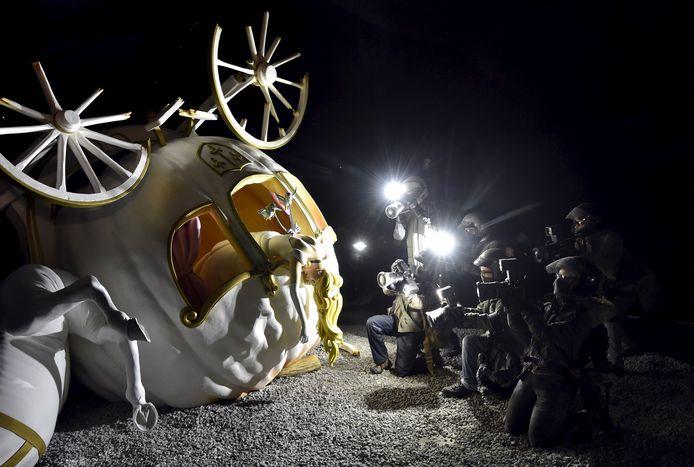
Banksy’s ‘Dismaland’: Antagonistic Participatory Art or Contemporary Engagement Fad?
‘Dismaland’ was a temporary, collaborative art project led by the famous street artist Banksy installed at the abandoned recreational spot ‘The Tropicana’ in Somerset, England. The project, which ran from August 21st to September 27th 2015, was a dystopian parody of the Disneyland theme park and was likely inspired by the pessimistic “Dismayland” slumscape paintings created by the American artist Jeff Gillette, who also participated in the project (Holmes, 2016).
As is characteristic of Banksy’s work, the art featured in the project draws our attention to a wide variety of topical, societal issues. One exhibit, for example, criticizes the way groups of refugees are sent back and forth between borders by allowing visitors to steer a small boat full of refugee figures around a pond. Another, a statue of an orca jumping out of a toilet and through a hoop, is a critique of parks such as SeaWorld, which display and commodify sea animals that have been taken out of their much larger, natural environments for our entertainment. (Oftentimes under the guise of the protection of endangered species.)
Visitors were encouraged to interact with many aspects of the art project; one could go for a ride on the ‘slaughterhouse’ carousel or participate in one of the many obviously rigged carnival games. Furthermore, typical theme park amenities which visitors could interact with such as food carts, the merchandise store, customer support and even security were transformed into critical art pieces of their own that fit the theme of the project.

Figure 1) Cinderella's crashed carriage at 'Dismanland'
However, not all of the artworks made by the 58 artists who were part of the ‘Dismaland’ project (like the previously discussed orca statue) were inherently interactive in nature and most of them had an aesthetic value separate from their value as an interactive or participatory piece. The installation of Cinderella’s crashed carriage that is surrounded by fake cameras (see figure 1), which draws clear parallels to the sensationalised death of Princess Diana, for example, can still be critiqued even if no one went to see the artwork in person; its message does not disappear if there is no participation.
This begs the question of whether ‘Dismaland’ can be classified as an example of participatory art at all. One could argue that the project simply capitalized on the popular, contemporary tendency to create interactive art that engages the audience. However, I would like to argue that it is not the art installations themselves that are inherently participatory, but that their inclusion into the overarching art project of ‘Dismaland’ grants them their status as participatory artworks.
Because the ‘Dismaland’ project is framed as a theme park experience, the audience becomes part of the project through their transformation into theme park visitors. Their inclusion as theme park guests who consume for their own enjoyment, rather than as the audience of an artwork who serves to critique what they experience, heightens already existing meanings and also creates new layers of meaning that would not have been there if not for the eager participation of the visitors in the overarching project. For example, in the previously mentioned Cinderella installation, visitors become complicit in the perpetuation of the consumption of tragic spectacles through their own viewing of the artwork.
In this, the absurdist eagerness of visitors to participate is key to the art project and becomes part of the societal critiques it is trying to offer. Visitors were all too willing to participate in their own nonsensical surveillance at the luggage check, they lined up to ride the carousel whose horses were awaiting a grim fate as lasagne filling and happily paid for rigged carnival games that they were guaranteed to lose without realising the irony of their participation. This meaning of the Populus turning a blind eye to the immoral or even unethical origin of their entertainment consumption would have been lost if there had not been such an overwhelming interest in the ‘Dismaland’ project. The meaning of many other artworks would also have been weakened.
Because the visitors’ participation in the overarching art project adds new layers of meaning to the ‘Dismaland’ project as well as its individual art installations, ‘Dismaland’ should be considered a case of participatory art. Interestingly, the project does not perfectly fit within one of the three participatory art categories described by Finkelpearl (2014). Although the project does appropriate the form of the theme park visit, which would make it a relational participatory artwork, it does not try to realistically depict the theme park experience. Instead, it offers participants a depressive, parodied version of the theme park experience that is controversial, confrontational and destabilizing. This makes ‘Dismaland’ a borderline case of a mix between the relational and antagonistic categories of participatory art.
References
Finkelpearl, T. (2014). Participatory art. In M. Kelly (Ed.), Encyclopedia of aesthetics. Oxford University Press.
Holmes, K. (28 June 2016). Meet the 'Slumscape' Painter Who Inspired Banksy's Dystopian Theme Park. Vice.